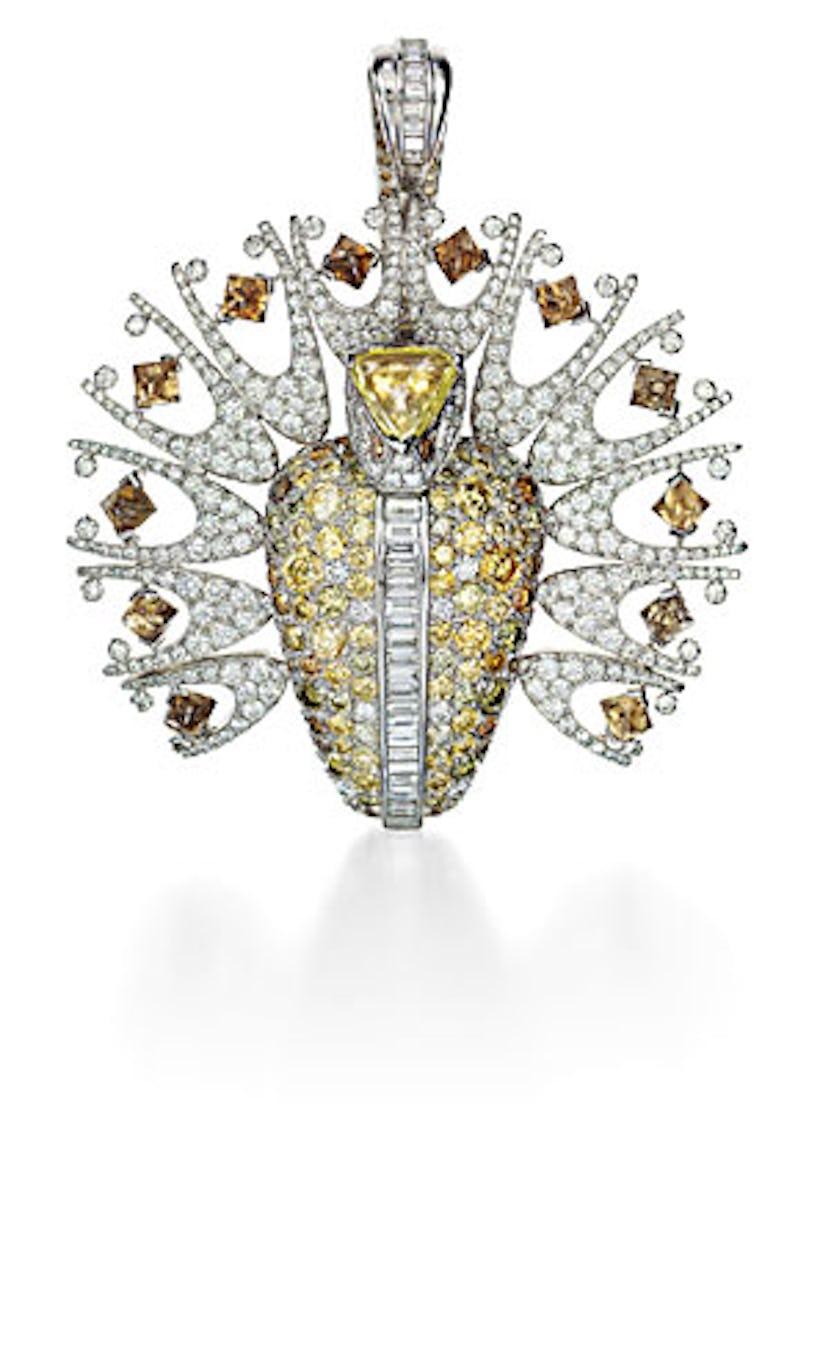Fire and Ice
With its latest collection, De Beers taps into the myth of a diamond-studded valley ringed by flames.

Anyone within a 10-mile radius of a television is familiar with the De Beers ads. We know the catchphrases. We know to expect a tug at the heartstrings when we witness one of those diamonds-are-forever moments. There’s inevitably a couple, perhaps some folksy Cat Power vocals or the dramatic surging of an orchestra, and then the gentleman’s proffered token of love—fabulously radiant diamonds.
Indeed, if there were ever a company with a lockdown on romance, De Beers is it. Now, however, the house is broadening its range of core motifs to include bewitching serpents, giant phoenixes and an impressive roster of heroes ranging from Alexander the Great to Sinbad the Sailor.
Enter the Valley of Diamonds collection, a 13-piece lineup of rings, necklaces and a single pair of earrings inspired by an ancient myth of the same name. The origins of the tale vary—the Chinese, Indians and Persians all had their versions, some dating as far back as the eighth century—but the premise is invariably the same: an impossible-to-reach valley richly covered in diamonds. And the obstacles for the protagonists are always plentiful. As if menacing surrounding mountains aren’t enough (“So steep that no man could climb them,” recounts Sinbad in One Thousand and One Nights), the area is also ringed with walls of fire and inhabited by dangerous snakes whose gaze can strike a man dead, natch. “It’s the ultimate place you want to get in but can’t,” says De Beers’s creative director, Raphaele Canot, who spearheaded the project’s design. “I loved the idea of danger, the adventure part of the myth.”
Another key element to the story is giant birds, who unwittingly carry the jewels off for safekeeping. As the lore goes, people would toss slabs of fresh meat into the valley so the diamonds would stick to them. The whole lot would then be snatched up by the winged creatures for food and brought to their nests on more accessible ground. There’s a Marco Polo version, which is somewhat cruder; in that one, the birds swallow the meat, and the jewelers simply wait for nature to take its course.
Understandably, the folks at De Beers took a little creative license with the tale, folding in snippets of other fables here and there and making some edits. Gone, for example, is the carnivorous bait. The birds are now glorious phoenixes who’ll simply deliver you to the iced finery. The Valley of Diamonds, moreover, is flush with magical flowers and the sacred Hindu mahua tree—all represented in luxed-up form in the line, which is currently making the international rounds via a traveling exhibit through select De Beers stores.
But that’s not the only rewriting going on. The Valley of Diamonds marks the company’s first true thematic collection. Previous offerings, like 2006’s Secrets of the Rose, were more general in concept, and in many ways, this is Canot and team’s way of giving De Beers’s still-young jewelry a history of its own. The diamond behemoth may date back a century, but the retail arm of the concern, a joint venture with LVMH, is a mere seven years old—a newbie compared with competitors like Cartier, Canot’s former stomping ground. “We don’t have a big archive, a big history,” the gamine Frenchwoman says, “so we are creating the story for De Beers.
“Our identity is in looking closer to the myth of diamonds. It’s different from all the others,” Canot continues. “We are not going to do the Hollywood story, because Harry Winston has it, or the jewelers of kings story, because Cartier has it. We have our own identity that we’re building on two pillars of diamond meanings—love on one side and mystery and legend on the other.”
In keeping with this spirit, each of the Valley of Diamonds designs incorporates both rough and polished diamonds, an MO shared with the firm’s Talisman collection. Launched in 2005, Talisman tapped into the stone’s purported healing and protective qualities. That contrast, and its mystical implications, is being developed into a De Beers jewelry signature—“primitive and modern,” as Canot says. In the Valley of Diamonds the Naja Naja snake ring, for example, is comprised of 13 raw diamonds interspersed among white and fancy colored pavé and baguette stones. Another serpentine piece, named Guardian of the Myth, has an uncut seven-carat diamond in the animal’s jaws, while the Mahua ring has seven polished yet rough diamond beads below a bed of pavé and pebblelike gems. The pièce de résistance, though, is the King Cobra pendant, an uncut-cut combo totaling nearly 25 carats. All the pieces are one-of-a-kind save two: rings shaped like the wings of a phoenix and a snake’s profile. “De Beers was one of the first to work with rough diamonds,” says the firm’s CEO, Guy Leymarie, explaining the point-counterpoint aesthetic. “This was relevant for us.”
For a woman in the mood for something with even more bite, Canot calls attention to the Komodo ring, shaped like a dragon’s head. “It’s the most poisonous creature of the story,” she says, popping open its mouth to reveal a hidden compartment. “You can add something very precious to you.” Such as? Canot responds with a grin and sticks to the tale she’s telling: “Perhaps a magic potion.”